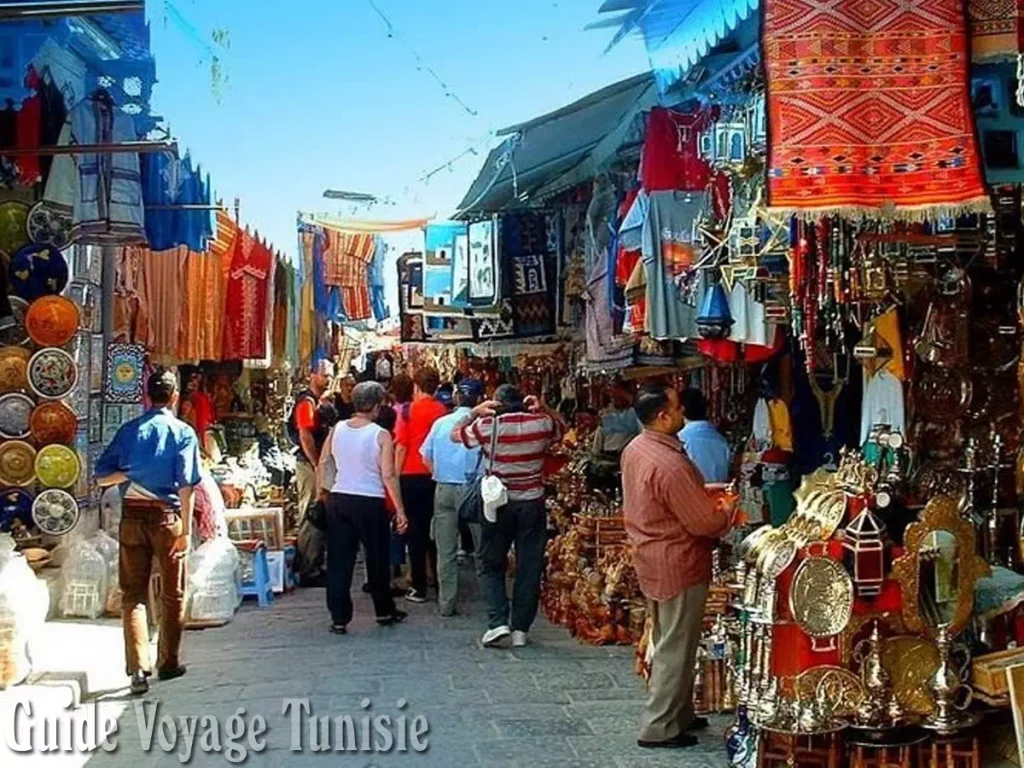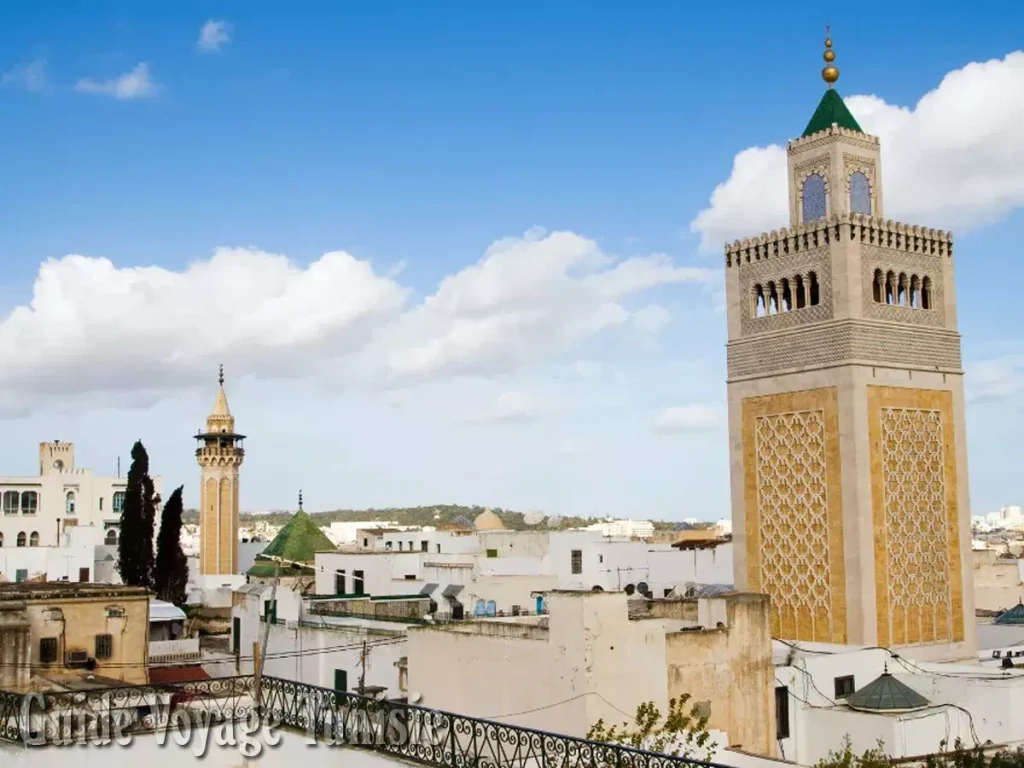The Medina of Tunis
Classified as a UNESCO World Heritage Site, the medina of Tunis is nowadays one of the most complete and richest in the Arab-Muslim world. In this article, we briefly present this magnificent medina. We will discuss its history, its organization, and some monuments to visit.
In addition, we have carried out several discovery circuits in different sectors of the old town (West, North and Center sectors). These routes allow you to discover the architectural, artistic or religious riches of the medina.
History and evolution of the medina of Tunis
From Carthage to the Hafsids: installation of power
Developed since antiquity, Tunis has long remained a simple village perched on a hill, wedged between the gulf on one side and a lake behind. The Arab conqueror of Carthage, Hassan Ibn Noomen, chose the site in 698 to settle. It is then the end of the Byzantine domination over the region.
In the 8th century, the city was organized around the Great Mosque, the Zitouna, towards which two axes converged: the first in a North-South direction serving the surrounding countryside and the second in an East-West direction which joins the sea to the hill. . Tunis then experienced a period of prosperity and surrounded itself with protective ramparts.
However, the Arab conquerors preferred the center of the country to create the city of Kairouan, the political and religious capital. In the 11th century, during the invasions of the Beni Hilal tribes from Egypt, Kairouan was devastated.
However, a small Berber dynasty, the Béni Khorassan, settled in Tunis and organized a kind of independent republic, sheltered from Arab invaders and Norman incursions.
The fate of Tunis is definitively fixed in the 12th century. Abdelmoumen from Marrakech unifies the Maghreb and Andalusia. Tunis becomes the capital of the conquered country. He installed a governor there, Abdelwahab Ibn Hafs. The Hafside dynasty, created by his son Abou Zakaria el Hafsi, will be at the origin of the organization and development of the new maritime city (13th and 14th centuries).
From the Hafsids to the Mouradites: development of the medina
The geographical situation of Tunis favors the extension of the city which is covered with beautiful monuments: mosques, fondouks, souks, palaces and rich residences. Outside the ramparts, the surroundings have many gardens and orchards. Dominating the city, the Kasbah of the Hafsid sultans contains administrative services and palaces. The struggle between Spaniards and Turks for preponderance in the Mediterranean in the 16th century disturbed this rather calm and prosperous period. A last sultan maintained without real power by Charles V and his troops installed in Tunis and La Goulette was definitively overthrown by the Turks, winners of the Spaniards.
From then on, the country fell back under the dependence of an Eastern Muslim empire as an Ottoman province. Tunis was then governed successively by a Pasha, a Dey and then a Bey following palace intrigues. Despite its rivalries between contenders for power, the country is enjoying a certain prosperity. The first religious buildings were erected outside the palaces by Othman Dey and Youssef Dey, his successor. After him, the power of the deys will weaken in favor of the beys. One of them, Mourad, obtains the title of Pasha and the right to transmit the office of bey to his son Hamouda, thus founding the Mouradite dynasty which ends tragically in a succession of fratricidal struggles.
Restaurant in the patio of Dar Hamouda Pacha, one of the best restored palaces in the medina of Tunis
The patio of Dar Hamouda Pacha, one of the best restored palaces in the medina
From the Husseinites to the Protectorate: urbanization outside the medina
Hussein Ben Ali was then elected bey. The Husseinite dynasty will govern the country until the proclamation of the Tunisian Republic in 1957. Between the end of the 18th and the beginning of the 19th century, Hamouda Pasha the Husseinite appears as the last great sovereign of the Regency of Tunis. By putting an end to the incessant incursions of the Algerians, he, with his main minister Youssef Saheb Ettabaa, gave new impetus to all the activities of the kingdom.
But the happy results obtained thanks to a wise administration will be compromised by an opposite policy. The ambition of Ahmed Bey aiming at a too rapid transformation of his State by modern and costly achievements will lead it to ruin. The venality of his entourage and the weakness of his successors only aggravated the situation and precipitated the advent of the Protectorate in 1881 by the French.
Map and neighborhoods
The doors
The organization of the medina of Tunis has changed little over the centuries. A huge wall delimited the medina. Doors (Bab) made it possible to enter and leave the city. The wall has almost completely disappeared, but the doors and still exist.
The best known and most visible is Bab el Bhar (literally Gate of the Sea, because it opens on the Mediterranean side). It is also called Porte de France. This colossal gate is at the end of the busy Avenue Bourguiba. Three other gates still exist, namely Bab Jedid, Bab Saadoun and Bab el Khadra.
Bab el Bhar (Porte de France), one of the main entrances to the medina
Finally, other doors no longer exist, destroyed in particular in the middle of the 19th century. But the names remained, given to many neighborhoods in the center of Tunis. For example: Bab Alioua, Bab Laasal, Bab EL Jazira, Bab Mnara, Bab Souika, Bab Lakouas…
These districts, originally located on the outskirts of the medina, are now located in the heart of Tunis, posing obvious traffic problems.
The bazaars
The heart of the medina of Tunis was divided into several markets, the famous souks. Multitude of alleys, areas covered in arcades, perfumes, hyper-activity are different factors that make it so charming. In a classic way in Arab architecture, each souk had its specialty (souk of butchers, jewelers, tanners, potters, chechia…). With the disappearance of certain trades, several souks have disappeared. There then remains a neighborhood name or a street name recalling this story.
Entrance to the Souk el Blat (herbalists market) in the medina of Tunis
The Souk el Attarine, perfumers’ district, in the medina of Tunis
Some souks have nevertheless persisted to the present day. Thus, the souks of grocers, blacksmiths (and many others), are still active, condensed in the heart of the medina. An entire sector, the most “picturesque”, is occupied by sellers of tourist products. The hordes of tourists come there to buy so-called “oriental” products which are more Chinese than typically Tunisian… This souk is easy to access: from Porte de France, just go up the street which goes to the left. The trinket shops then follow one another over 500 meters.
The street that goes to the right is devoted to clothing (fashion, tradition, weddings, etc.). Be careful, there are often crowds: it’s the souk!
The Souk where you can find everything you need for a good wedding!
Major monuments
The upper part of the medina of Tunis has always been a political place. Currently there is the palace of the 1st minister, the ministry of finance, the Kasbah, but also all the judicial pole (palace of Justice, Bar, School of the magistrature…).
This sector is also home to most of the large private palaces. They often served as residences or palaces during the period of the Beys, for example Dar Hamouda Pasha. Some are open to visitors or have become places of culture (cultural café, library, gallery, concert hall). These palaces certainly deserve an in-depth visit.
Bir Lahjar, cultural center regularly organizing artistic events (40, rue du Pacha)
The medina of Tunis is also, since its beginnings, an important religious center. Thus, the great Zitouna mosque (the olive tree), located between souks and palaces, is an architectural and theological reference for many Tunisians. Its minaret is visible from the nearby alleys or from the many terraces accessible from the shops. It is possible, under certain conditions, to visit the mosque.
Numerous mosques, mausoleums, marabouts and zaouias dot the medina. The calls to prayer become amazing, when several calls echo through the alleys. Below, the mosque of Youssef Dey, located between the Kasbah and the Zitouna mosque.
The mosque and mausoleum (green roof) of Hamouda Pasha
The entire medina of Tunis, thanks to this historical, architectural and cultural richness, has been listed as a UNESCO World Heritage Site since 1979 (link to UNESCO site)
Discovery tours
In order to better discover the medina and its rich history, we offer discovery tours in the medina on the site.
These routes allow you to travel:
West of the medina: route through the palaces and large bourgeois houses located between the Kasbah and Bab Souika, with many addresses that can be visited
the northern part of the medina: route in the area of Place Halfaouine, Bab Saadoun and Bab el Khadra
the central part of the medina: route in the central part, mixing the visit of many monuments and large houses.
Of course you can adapt these itineraries according to your favorite themes, the time available…
Do not hesitate to come at different times of the day, in order to better understand the rhythms of life in the medina. The morning is thus very active while the early evening is calm. The light at dusk is very interesting for photographers.
The medina of Tunis in pictures

